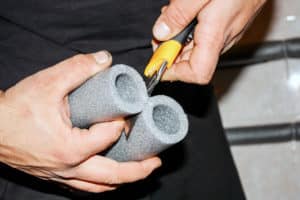
Want to find out more?
Call ProMaster at:
513-322-2914
Which Pipes Are Most Likely to Freeze?
Knowing how to prevent frozen pipes means knowing where problems may occur. The majority of pipes that freeze do so in unconditioned or poorly insulated areas. This means basements, crawlspaces and attics are common problem areas. Additionally, hose-bibbs and under-cabinet plumbing on exterior walls are also possible areas of concern. While most pipes freeze when outside temperatures dip below 20°, your home is at risk on any below-freezing night if the proper steps aren’t taken.
Winterize Your Hose-Bibb

Insulate Pipes on Exterior Walls

Let Your Faucet Drip

Turn Up the Heat
Again, turning up the heat in your home will cost you a little bit of money. It could save you a bunch, however, if it can help prevent frozen pipes in your home. Turning up your thermostat a couple of degrees (and leaving it there overnight) can add that little bit of extra warmth your plumbing needs. Space heaters can also do the trick in the right places. Just be careful about utilizing them in places where water is common, like a under a faucet.
Open Your Cabinets
You don’t have to open every cupboard in your home, but opening cabinet doors where plumbing is accessible can help their temperature rise by several degrees. This is especially true for plumbing that’s found on exterior walls.
Prevent Frozen Pipes In Your Home
It only takes a little bit of effort to make a big difference in the condition of your home’s plumbing. Not every pipe, however, is easily accessible. If you need help with any of these tasks, or already find yourself with water damage, no problem. Just hail a ProMaster “Home Repair Hero” today! You can schedule online, use the “Reach Out” form at the bottom of this page, or call 513-322-2914.




Speak Your Mind